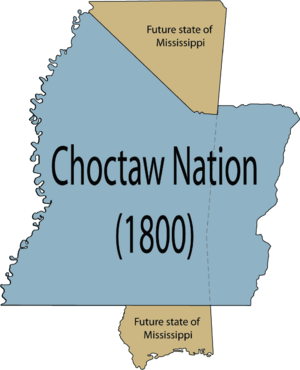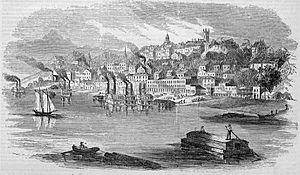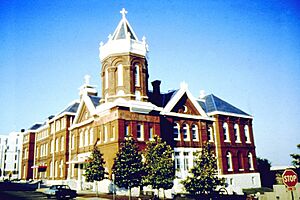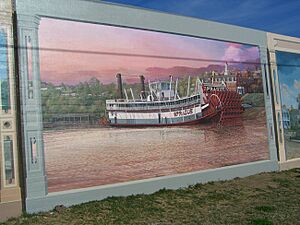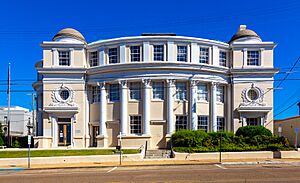Vicksburg, Mississippi facts for kids
Quick facts for kids
Vicksburg, Mississippi
|
|||
|---|---|---|---|
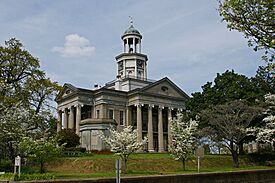
Old Warren County Courthouse ("Old Courthouse Museum")
|
|||
|
|||
| Nickname(s):
"Gibraltar of the Confederacy", "Red Carpet City of the South"
|
|||

Location of Vicksburg in Warren County, Mississippi
|
|||
| Country | United States | ||
| State | Mississippi | ||
| County | Warren | ||
| Founded | 1811 | ||
| Incorporated | January 29, 1825 | ||
| Named for | Newitt Vick | ||
| Area | |||
| • City | 35.093 sq mi (90.890 km2) | ||
| • Land | 33.017 sq mi (85.513 km2) | ||
| • Water | 2.076 sq mi (5.377 km2) | ||
| Elevation | 200 ft (60 m) | ||
| Population
(2020)
|
|||
| • City | 21,573 | ||
| • Estimate
(2023)
|
20,192 | ||
| • Density | 611.49/sq mi (236.10/km2) | ||
| • Urban | 25,888 | ||
| • Metro | 42,298 (US: 296th) | ||
| Time zone | UTC−6 (Central (CST)) | ||
| • Summer (DST) | UTC−5 (CDT) | ||
| ZIP Codes |
39180, 39181, 39182, 39183
|
||
| Area code(s) | 601 and 769 | ||
| FIPS code | 28-76720 | ||
| GNIS feature ID | 2405648 | ||
| Sales tax | 7.0% | ||
Vicksburg is a city in Warren County, Mississippi, United States. It is the main city of the county. In 2020, about 21,573 people lived there. Vicksburg is on a high bluff (a steep cliff) on the east side of the Mississippi River. It is right across from Louisiana.
French settlers built Vicksburg in 1719. The local Natchez people attacked the outpost, but it survived. The city was officially named Vicksburg in 1825. It was named after Newitt Vick, a Methodist missionary. The Natchez Native Americans lived in this area for a long time. They had their own land along the Mississippi River.
During the American Civil War, Vicksburg was a very important port for the Confederate side. In July 1863, it surrendered to Ulysses S. Grant's army. This event, along with the Battle of Gettysburg, was a major turning point in the war. After the war, during the Reconstruction era, white supremacists and the Democratic Party took back power. This included a time of conflict in 1874 and 1875. Today, most of Vicksburg's population is African American. The city is also home to three large offices of the United States Army Corps of Engineers. They often help with flood control in the area.
Contents
History of Vicksburg
The land where Vicksburg is today was once home to the Natchez Native Americans. They lived along the Mississippi River. Their language was different from other tribes in the area. Before the Natchez, other native groups lived here for thousands of years.
The first Europeans to settle were French colonists. In 1719, they built Fort Saint Pierre. This fort was on high bluffs overlooking the Yazoo River. This area is now Redwood. The French traded furs with the Natchez and started farms.
On November 29, 1729, the Natchez attacked the fort and farms. They killed many settlers and took women and children captive. The French, with help from the Choctaw tribe, defeated the Natchez. The Choctaw then took over the area.
In 1801, the Choctaw gave up a large amount of land to the U.S. government. This was part of the Treaty of Fort Adams. This treaty was one of many that led to the removal of most Choctaw people. By 1830, most Choctaw moved west of the Mississippi River. Some Choctaw stayed in Mississippi. They became citizens and tried to keep their culture alive.
In 1790, the Spanish built a military outpost here called Fort Nogales. "Nogales" means "walnut trees." When Americans took control in 1798, they changed the name to Walnut Hills. In 1825, the small village became Vicksburg. It was named after Newitt Vick, a Methodist minister. He had started a Protestant mission in the area.
In 1835, there was some trouble in Vicksburg. Citizens wanted to remove gamblers from the city. They felt the gamblers were disrespectful to the people living there. This event was a serious outbreak of violence in the slave states before the Civil War.
Vicksburg in the Civil War
During the American Civil War, Vicksburg was a very important city. It finally surrendered during the Siege of Vicksburg. After this, the Union Army gained control of the entire Mississippi River. The siege lasted 47 days. The Union army tried to starve the city into giving up. Vicksburg was on a high bluff, making it hard to attack.
Confederate General John C. Pemberton surrendered Vicksburg on July 4, 1863. The day before, General Robert E. Lee was defeated at Gettysburg. These two events are seen as the turning point of the Civil War. They helped the Union side win the war.
Some stories say Vicksburg residents did not celebrate July 4th again until 1945. This was after the U.S. won World War II. But this is not completely true. Big July 4th celebrations were happening by 1907. Smaller celebrations happened even before that.
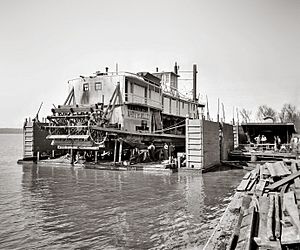
In the 1800s, Vicksburg was a busy trading city. It was on the Mississippi River, so many steamboats came through. The city shipped out cotton from nearby areas.
In 1876, a flood on the Mississippi River changed its path. This left Vicksburg with less access to the main river channel. The city's economy suffered a lot.
Changes After the Civil War
After the Civil War, white Confederate veterans formed groups like the Ku Klux Klan. These groups attacked black people and their supporters. By the mid-1870s, new white groups like the Red Shirts appeared in Mississippi. White people wanted to regain political power over the black majority. Elections were often unfair, with violence and cheating. White people tried to stop black Republicans from voting.
In August 1874, a black sheriff named Peter Cosby was elected in Vicksburg. White people prepared for what they called a "race war." They bought new guns. On December 7, 1874, white men broke up a black Republican meeting. They held Sheriff Cosby and then forced him out of town. He told black people from the countryside to go home. On their way, some were attacked by armed white men. Over the next few days, armed white groups attacked black areas. Many black people were killed. The Red Shirts were active in Vicksburg. Black people asked the government for help, but it was not always given.
President Ulysses S. Grant sent Federal troops to Vicksburg in January 1875. A committee looked into what was called the Vicksburg Riot (also known as the Vicksburg Massacre by some newspapers). They heard from both black and white residents. But no one was punished for the deaths. The Red Shirts and other white groups stopped Republicans from voting. Smaller conflicts happened until the 1875 elections. White Democrats then took control of the state government. Other southern states copied this "Mississippi Plan." It was a way to stop black people from voting and unite white people under the Democrats.
From 1890 to 1908, new laws were passed in southern states. These laws made it very hard for most black people and many poor white people to vote. They used things like poll taxes, literacy tests, and grandfather clauses. They also passed Jim Crow laws. These laws created racial segregation in public places.
Vicksburg in the 20th Century
Most black people were kept out of the political system for many years. This changed after new civil rights laws were passed in the mid-1960s.
In 1903, the United States Army Corps of Engineers changed the path of the Yazoo River. This helped make Vicksburg's waterfront better. For a long time, people crossed the river by ferry. Then, a bridge for both trains and cars was built in 1929. Vicksburg has the only bridge crossing the Mississippi River between Baton Rouge and Memphis. It is also the only highway crossing between Greenville and Natchez.
Interstate 20 was built across the river after 1973. Freight trains still use the old bridge. U.S. Highway 61 runs north and south through the city.
On March 12, 1894, Coca-Cola was bottled for the first time in Vicksburg. This was done by Joseph A. Biedenharn, a local candy maker. Today, old Coca-Cola bottles from the 1800s are very valuable to collectors. His original candy store is now the Biedenharn Coca-Cola Museum.
During the Great Mississippi Flood of 1927, Vicksburg was a main place for people seeking safety. Many homes and farms were flooded. Temporary shelters were set up for thousands of people.
Because of the huge damage from the flood, the U.S. Army Corps of Engineers created the Waterways Experiment Station. This lab helps develop ways to protect farms and cities from floods. It is now called the Engineer Research and Development Center. They work on military engineering, information technology, and flood control.
In December 1953, a strong tornado hit Vicksburg. It killed 38 people and destroyed almost 1,000 buildings.
After World War II, many black veterans returned home. They had fought for their country and wanted full rights as citizens. They became active in the civil rights movement. In the 1960s, activists in the Vicksburg Movement became well-known.
Vicksburg Today
In 2001, people from Vicksburg visited a mural project in Kentucky. They wanted ideas for their own city. In 2002, the Vicksburg Riverfront murals program began. Artist Robert Dafford and his team painted murals on the floodwall downtown. The murals show Vicksburg's history. Topics include President Theodore Roosevelt's bear hunt, famous steamboats, the Siege of Vicksburg, and the Great Mississippi Flood of 1927. The project finished in 2009.
In 2010, a new large mural was painted across from the original project. It shows the "Run thru History" event at the Vicksburg National Military Park.
In December 2014, a meeting was held about the 140th anniversary of the Vicksburg Riots of 1874. Scholars gave talks, and there was a discussion at the Vicksburg National Military Park.
Geography of Vicksburg
Vicksburg is located at 32°20′10″N 90°52′31″W / 32.33611°N 90.87528°W. The city covers about 35.3 square miles (91.4 km²). Most of this area is land, with some water.
Vicksburg is where the Mississippi River and Yazoo River meet. A large part of the city sits on top of a high bluff. This bluff is on the east bank of the Mississippi River.
Population and People
| Historical population | |||
|---|---|---|---|
| Census | Pop. | %± | |
| 1850 | 3,678 | — | |
| 1860 | 4,591 | 24.8% | |
| 1870 | 12,443 | 171.0% | |
| 1880 | 11,814 | −5.1% | |
| 1890 | 13,373 | 13.2% | |
| 1900 | 14,834 | 10.9% | |
| 1910 | 20,814 | 40.3% | |
| 1920 | 18,072 | −13.2% | |
| 1930 | 22,943 | 27.0% | |
| 1940 | 24,460 | 6.6% | |
| 1950 | 27,948 | 14.3% | |
| 1960 | 29,143 | 4.3% | |
| 1970 | 25,478 | −12.6% | |
| 1980 | 25,434 | −0.2% | |
| 1990 | 20,908 | −17.8% | |
| 2000 | 26,407 | 26.3% | |
| 2010 | 23,856 | −9.7% | |
| 2020 | 21,573 | −9.6% | |
| 2023 (est.) | 20,192 | −15.4% | |
| U.S. Decennial Census 2020 Census |
|||
In 2022, there were about 8,092 homes in Vicksburg. Each home had about 2.57 people. The average household income was $45,147. About 25.5% of the people in the city live below the poverty line. About 55.1% of the people have jobs. Also, 25.3% of the people have a bachelor's degree or higher. About 86.1% have a high school diploma.
Most people reported their ancestry as English (94.3%). Other ancestries included Spanish (2.9%) and Indo-European (1.8%). The average age in the city was 37.6 years old.
2020 Census Data
| Race | Num. | Perc. |
|---|---|---|
| White | 5,974 | 27.69% |
| Black or African American | 14,423 | 66.86% |
| Native American | 27 | 0.13% |
| Asian | 209 | 0.97% |
| Other/Mixed | 537 | 2.49% |
| Hispanic or Latino | 403 | 1.87% |
As of the 2020 United States Census, there were 21,573 people living in Vicksburg. There were 8,969 households and 4,864 families.
Economy and Jobs
Vicksburg is home to three large offices of the US Army Corps of Engineers. These include the Engineer Research and Development Center (ERDC). The ERDC also has the Waterways Experiment Station. The Mississippi Valley Division headquarters and the Vicksburg District headquarters are also here.
The 412th Engineer Command of the US Army Reserve is in Vicksburg. So is the 168th Engineer Brigade of the Mississippi Army National Guard.
The United States Coast Guard has a unit in Vicksburg. It helps with navigation on the Lower Mississippi River. This unit operates a buoy tending vessel called the USCGC Kickapoo.
In 2017, Emma Green from The Atlantic said that the Army Corps of Engineers helps the town's economy a lot. About 12.3% of the local workers are employed by the federal government.
Casinos in Vicksburg
Vicksburg has four casinos along the Mississippi River:
- Ameristar Casino Vicksburg
- Casino Vicksburg (formerly Lady Luck Casino Vicksburg)
- Riverwalk Casino Hotel
- Water View Casino
Arts and Culture
Yearly Events
Every summer, Vicksburg hosts the Miss Mississippi Pageant and Parade. Also, the Vicksburg Homecoming Benevolent Club holds a homecoming weekend. This event gives scholarships to high school seniors. Former residents from all over the country come back for this event.
Since 1936, the Vicksburg Theatre Guild has put on a show called Gold in the Hills. It holds a Guinness World Record for being the longest-running show.
Places to Visit
- Vicksburg City Hall, a beautiful building from 1902.
- Anchuca Mansion (built in 1830).
- Balfour House (built in 1835).
- Beck House (built in 1875).
- The Magnolias (built around 1877–1880).
- McRaven House (built around 1797).
- Old Court House Museum (built in 1861).
- Vicksburg National Military Park
- Vicksburg Riverfront Murals (painted in 2002 and 2012).
- Vicksburg Theatre Guild
Education and Schools
The schools in Vicksburg are part of the Vicksburg-Warren School District.
High Schools
- Vicksburg High School (a National Blue Ribbon School in 1988–1989).
- Warren Central High School.
Junior High Schools
- Vicksburg Junior High School
- Warren Central Junior High School
- Academy of Innovation
Elementary Schools
- Beechwood Elementary School
- Bovina Elementary School
- Bowmar Avenue Magnet School
- Dana Road Elementary School
- Redwood Elementary School
- Sherman Avenue Elementary School
- South Park Elementary School
- Warrenton Elementary School
- Vicksburg Intermediate School
- Warren Central Intermediate School
Private Schools
- Porters Chapel Academy
- Vicksburg Catholic School - St. Francis Xavier Elementary and Saint Aloysius Catholic High School.
- Vicksburg Christian Academy
- Vicksburg Community School (K-12)
Former Schools
- Hall's Ferry Road Elementary School (a National Blue Ribbon School in 1985–1986).
- Culkin Elementary School
- Jett Elementary School
- Cedars Elementary School
- Vicksburg Middle School
- All Saints' Episcopal School was a boarding school that closed in 2006. It is now a campus for AmeriCorps NCCC.
- St. Mary's Catholic School served the African-American community.
- McIntyre Elementary School served the African-American community.
- Magnolia Avenue School was renamed Bowman High School.
- Rosa A. Temple High School served the African-American community.
- King's Elementary School served the African-American community.
- Carr Central High School.
- J.H. Culkin Academy.
- H.V. Cooper High School.
- Jefferson Davis School.
- Oak Ridge School.
- Eliza Fox School.
- All Saints' College. This was an Episcopal college for white women. It opened in 1908 and closed in 1962.
Colleges and Universities
Warren County is part of the Hinds Community College district.
Media in Vicksburg
Newspapers
The Vicksburg Post is the local newspaper. It used to be called the Vicksburg Evening Post.
Radio Stations
Television Stations
Transportation
For many years, the Yazoo and Mississippi Valley Railroad and then the Illinois Central Railroad had passenger train service through Vicksburg. Trains went north to Memphis, Tennessee and south to New Orleans. Other trains went east to Jackson and Meridian, and west to Monroe and Shreveport's Union Station. The last passenger train left Vicksburg in 1967.
Interstate 20 runs east and west through the southern part of Vicksburg. U.S. Highway 80 also runs east and west through the city. U.S. Highway 61 runs north and south.
The closest airport with commercial flights is Jackson–Medgar Wiley Evers International Airport. It is about 53.2 miles east of Vicksburg. Vicksburg Tallulah Regional Airport and Vicksburg Municipal Airport are two smaller airports for general aviation.
Famous People from Vicksburg
- William Wirt Adams, a Confederate Army officer.
- Katherine Bailess, an actress, singer, and dancer.
- Earle Basinsky, a crime novelist.
- Ed Bearss (1923–2020), a historian of the American Civil War.
- Joseph A. Biedenharn (1866–1952), the first person to bottle Coca-Cola in Vicksburg in 1894.
- Johnny Brewer, a football player.
- Margaret Hunt Brisbane (1858–1925), a poet.
- Roosevelt Brown, a former baseball player for the Chicago Cubs.
- Ellis Burks, a former baseball player.
- Charles Burnett, a filmmaker.
- Malcolm Butler, a football player for the New England Patriots and Tennessee Titans.
- Odia Coates, a pop singer.
- Rod Coleman, a football player for the Atlanta Falcons.
- Caroline Russell Compton, a Mississippi artist.
- Mart Crowley, a playwright and TV executive.
- Jefferson Davis, President of the Confederate States of America.
- Bobby DeLaughter, a Mississippi state judge and prosecutor.
- Willie Dixon, a blues musician and songwriter.
- John "Kayo" Dottley, a college and professional football player.
- Myrlie Evers-Williams, a civil rights activist and journalist.
- Charley Fuller, a former NFL running back.
- Mark Gray, a country music singer.
- Louis Green, a football player for the Denver Broncos.
- DeMichael Harris, a wide receiver for the Indianapolis Colts.
- Milt Hinton, a jazz bassist.
- Jay Hopson, a football head coach.
- Joseph Holt, a long-serving Judge Advocate General of the Army.
- Delbert Hosemann Jr., Lt Governor of Mississippi.
- Hank Jones, a jazz pianist.
- Martin F. Jue, an inventor and entrepreneur in amateur radio.
- Patrick Kelly, a fashion designer.
- Brad Leggett, a football player for the Seattle Seahawks.
- George McConnell, a former guitarist for several bands.
- William Michael Morgan, a country music singer.
- Michael Myers, a football player for the Cincinnati Bengals.
- Key Pittman, a U.S. Senator from Nevada.
- Vail M. Pittman, the 19th Governor of Nevada.
- Dave Plump, a former NFL defensive back.
- Evelyn Preer, an African-American film actress.
- George Reed, a former running back for the Canadian Football League.
- Beah Richards, an African-American film and television actress.
- Kee Sloan, an Episcopal priest and Bishop of Alabama.
- Roy C. Strickland, a businessman and politician.
- Taylor Tankersley, a baseball pitcher for the Florida Marlins.
- John Thomas, a former baseball player.
- Mary T. Washington, the first African-American woman CPA.
- Carl Westcott, an entrepreneur.
- Delmon Young, a baseball outfielder for the Philadelphia Phillies.
- Dmitri Young, a baseball first baseman for the Washington Nationals.
Images for kids
See also
 In Spanish: Vicksburg para niños
In Spanish: Vicksburg para niños






